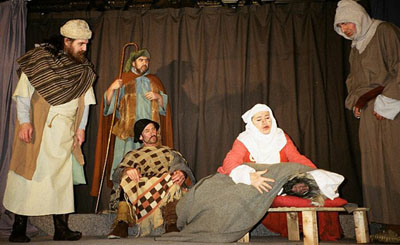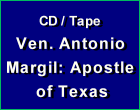Stories & Legends
 |
 |
 |
 |
 |
 |
 |
The Wakefield Shepherd's Play
The Christmas cycle of mystery plays was a part of medieval entertainment throughout England.
Of all the mystery plays produced during this more than 500 year era, the play enacted at Wakefield in the reign of Henry VI (1422-1461) and called The Second Shepherd's Play was surely one of the best and a favorite of the people. The play has two parts: one comic, and the other serious and pious.
The anonymous author, whom scholarship has labeled "The Wakefield Master," opens his Christmas office "in fields" where "certain poor shepherds" keep watch. One shepherd, the rascal Mak, steals a sheep while his companions sleep. Drawing a magic circle so that the sleepers will remain put, he lugs the sheep home to his sharp tongued wife Jill. Without time to kill it and dress it as mutton, they wrap it in baby's clothes and place it in a cradle.
 Later, the shepherds awaken, notice the lost sheep, and begin to search for it. The search leads them to Mak's cottage where the trickster deceives them by telling them that their new baby is asleep in the cradle and cannot be disturbed. After a quiet search of the premises, carefully avoiding going near the cradle so as not to wake the sleeping babe, the shepherds leave.
Later, the shepherds awaken, notice the lost sheep, and begin to search for it. The search leads them to Mak's cottage where the trickster deceives them by telling them that their new baby is asleep in the cradle and cannot be disturbed. After a quiet search of the premises, carefully avoiding going near the cradle so as not to wake the sleeping babe, the shepherds leave.
Unfortunately for Mak, one of them recalls that they have forgotten to bring the "new baby" presents. So they return and ask to give the babe a six pence and to kiss him. As they pull back the coverlet, they are startled by the long snout and ugly features.
Mak and Jill attempt to brazen things out by claiming the "baby" has been "forespoken" and switched by an elf for a fairy changeling. But the jig is soon up, and Mak, exposed, is tossed in a blanket for his greed. That ends Part One of the play, enjoyed by young and old alike.
Act two
Satisfied now, the shepherds go back to sleep. Before long they are reawakened by an Angel singing Gloria in excelsis who directs them to Bethlehem to see another newborn Babe. They gather together simple gifts to go to see the wondrous Child.
The play ends as the Virgin Mary tells them of God's goodness and power and the birth of the Messiah. The shepherds worship the Child and bid "farewell" to the "Lady so fair to behold with thy Child on thy knee" and depart singing.
The wagon on which this play was once acted was 30 feet long. At one end stood Mak's house. The fields with the shepherds were in the center. At the opposite end was Bethlehem with the stable and a crèche. It is a simple set for simple souls, yet The Second Shepherd's Play is much more sophisticated than the average medieval mystery play. Its pace is fast, its lines are witty, its characters and situations are "the best."
Mak and Jill are incorrigibles, lovers of life and the excitement of crime. Mak, suspected of the theft, points to the "child" in the cradle and swears "to God" that if he committed the crime, then "this be the first male that I shall eat this day." Jill picks up the lead, insisting if she is guilty she will eat "this child" that lies in the cradle. The shepherds gripe over high taxes, the shrewish dispositions of their wives. One husband warns young bachelors to be "well aware of wedding," pointing out that once you are in, you are in for good.
The shepherds are simple, but all have the capacity for awe and admiration. They are amazed by the Angel, and they select their gifts for the Christ Child (a bob of cherries, a bird, a ball) with naïveté and adoration.
The Second Shepherd's Play is seldom played today. But given a good translation, it would make good Christmas entertainment. Its comedy, its characters, its situations are arresting to anyone who loves to watch "what fools mortals be." It is simply "good theater," regardless of it being centuries old.


Of all the mystery plays produced during this more than 500 year era, the play enacted at Wakefield in the reign of Henry VI (1422-1461) and called The Second Shepherd's Play was surely one of the best and a favorite of the people. The play has two parts: one comic, and the other serious and pious.
The anonymous author, whom scholarship has labeled "The Wakefield Master," opens his Christmas office "in fields" where "certain poor shepherds" keep watch. One shepherd, the rascal Mak, steals a sheep while his companions sleep. Drawing a magic circle so that the sleepers will remain put, he lugs the sheep home to his sharp tongued wife Jill. Without time to kill it and dress it as mutton, they wrap it in baby's clothes and place it in a cradle.

The shepherds finding that the child is actually a sheep
Unfortunately for Mak, one of them recalls that they have forgotten to bring the "new baby" presents. So they return and ask to give the babe a six pence and to kiss him. As they pull back the coverlet, they are startled by the long snout and ugly features.
Mak and Jill attempt to brazen things out by claiming the "baby" has been "forespoken" and switched by an elf for a fairy changeling. But the jig is soon up, and Mak, exposed, is tossed in a blanket for his greed. That ends Part One of the play, enjoyed by young and old alike.
Act two
Satisfied now, the shepherds go back to sleep. Before long they are reawakened by an Angel singing Gloria in excelsis who directs them to Bethlehem to see another newborn Babe. They gather together simple gifts to go to see the wondrous Child.
 A "Lady so fair to behold with thy Child on thy knee"
A "Lady so fair to behold with thy Child on thy knee"
The wagon on which this play was once acted was 30 feet long. At one end stood Mak's house. The fields with the shepherds were in the center. At the opposite end was Bethlehem with the stable and a crèche. It is a simple set for simple souls, yet The Second Shepherd's Play is much more sophisticated than the average medieval mystery play. Its pace is fast, its lines are witty, its characters and situations are "the best."
Mak and Jill are incorrigibles, lovers of life and the excitement of crime. Mak, suspected of the theft, points to the "child" in the cradle and swears "to God" that if he committed the crime, then "this be the first male that I shall eat this day." Jill picks up the lead, insisting if she is guilty she will eat "this child" that lies in the cradle. The shepherds gripe over high taxes, the shrewish dispositions of their wives. One husband warns young bachelors to be "well aware of wedding," pointing out that once you are in, you are in for good.
The shepherds are simple, but all have the capacity for awe and admiration. They are amazed by the Angel, and they select their gifts for the Christ Child (a bob of cherries, a bird, a ball) with naïveté and adoration.
The Second Shepherd's Play is seldom played today. But given a good translation, it would make good Christmas entertainment. Its comedy, its characters, its situations are arresting to anyone who loves to watch "what fools mortals be." It is simply "good theater," regardless of it being centuries old.

Adapted from The Illustrated Book of Christmas Folklore,
New York: Seabury Press, 1973, pp. 99-100.
Posted December 26, 2012
New York: Seabury Press, 1973, pp. 99-100.
Posted December 26, 2012






